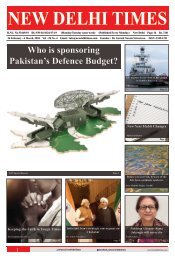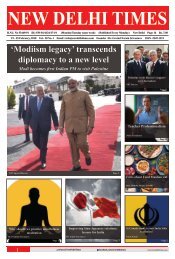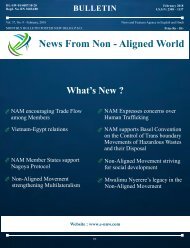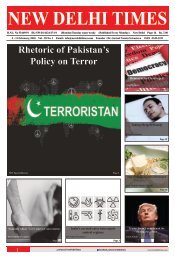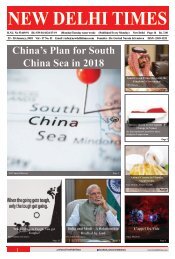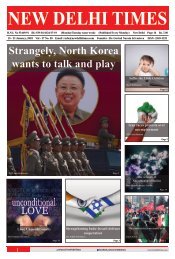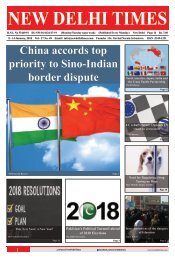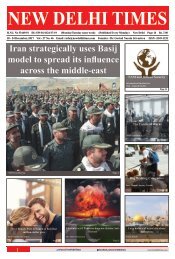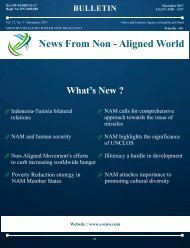29 January - 4 February 2018 - 16-min
Create successful ePaper yourself
Turn your PDF publications into a flip-book with our unique Google optimized e-Paper software.
<strong>29</strong> <strong>January</strong> - 4 <strong>February</strong>, <strong>2018</strong> 3<br />
I<br />
T<br />
Editorial<br />
◆◆<br />
By Dr. Ankit Srivastava<br />
Editor - in - Chief<br />
@AnkitNDT<br />
ankits@newdelhitimes.com<br />
NEW DELHI TIMES<br />
Netanyahu’s Historic India tour hails a ‘new era’ in Indo-Israel ties<br />
sraeli Prime Minister Benja<strong>min</strong> Netanyahu<br />
and his wife Sara Netanyahu arrived<br />
at the Air Force Station in New Delhi on<br />
14th <strong>January</strong> for the first visit by an Israeli<br />
leader to India in 15 years. He is only the<br />
second Israeli PM to visit India after Ariel<br />
Sharon in 2003. Modi had made history in<br />
July 2017 beco<strong>min</strong>g the first Indian leader<br />
to visit Israel.<br />
Netanyahu’s six-day long visit marks 25<br />
years of Indo-Israel diplomatic relations,<br />
extremely important in the backdrop of<br />
India’s vote in favour of a United Nations<br />
resolution that denounced United States<br />
Photo Credit : Shutterstock<br />
recognition of Jerusalem as Israel’s capital.<br />
While Netanyahu was ‘disappointed’, the<br />
Israeli ambassador to India played down,<br />
describing the relationship as ‘much stronger<br />
than one vote at the UN’. India-Israeli<br />
relationship is an important all-weather<br />
relationship that was strong enough to<br />
withstand fissures. Nothing could reverse<br />
it as both countries employ statesmanship<br />
◆◆By NDT Bureau<br />
@NewDelhiTimes<br />
info@newdelhitimes.com<br />
to maintain best of relations. Modi viewed<br />
Netanyahu’s visit as ‘historic and special’<br />
that will ‘further cement the close friendship<br />
between our nations’ while Netanyahu hailed<br />
Modi’s greeting as a ‘surprise welcome’<br />
that overrode a scheduled welcome by a<br />
Cabinet <strong>min</strong>ister. Cold War had witnessed<br />
Indian diplomacy leaning heavily towards the<br />
Palestinians at Israel’s cost. Over the past<br />
quarter century, both have inched closer.<br />
Pragmatic Modi understands real politic to<br />
orient all actions towards national interests.<br />
UN votes apart, there were other irritants<br />
like India cancelling the $500 million deal<br />
to buy 8,000 Spike anti-tank guided missiles<br />
from Israel’s state-owned defence contractor<br />
Rafael since DRDO offered to manufacture<br />
similar missiles at home. India needs Israel<br />
technology to further develop its capability.<br />
The army and the government are reportedly<br />
searching for ways of reviving the order.<br />
Israel is already a major weapons supplier<br />
to India, exporting an average of $1bn of<br />
military equipmentannually. India announced<br />
to buy 131 surface-to-air missiles from<br />
Israel for its first domestically made aircraft<br />
carrier. Seeking to end India’s status as the<br />
world’s top defence importer Modi invited<br />
Israeli defence companies ‘to take advantage<br />
of the liberalised foreign direct investment<br />
(FDI) regime to make more in India with<br />
our companies’. Technology transfer to local<br />
firms could create much-needed jobs.<br />
Both countries signed agreements on cyber<br />
security, air transport, energy, space cooperation<br />
and film production. The progress in<br />
implementation of agreements signed during<br />
Modi’s visit to Israel on technology, water<br />
and agriculture was also reviewed. The<br />
visit enhanced cooperation with a global<br />
economic, security, technology and tourism<br />
power.<br />
The largest-ever business delegation of around<br />
130 business people accompanying<br />
Netanyahu included executives in technology,<br />
agriculture and defence that ‘reflects the<br />
enthusiasm in Israel to do more business<br />
with India.’<br />
The India-Israel CEO Forum Meeting<br />
was a great success. At Mumbai - the seat<br />
of majority of India’s estimated 4,500<br />
Jews - Netanyahu visited Jewish centre<br />
Chabad House in a symbolic gesture to<br />
tiny and shrinking Jewish community. He<br />
met 11-year-old Moshe Holtzberg, whose<br />
parents were among <strong>16</strong>6 people killed in the<br />
2008 Mumbai attacks.<br />
Meeting with Bollywood lu<strong>min</strong>aries and<br />
producers he hosted a party to market<br />
Israel as a prime fil<strong>min</strong>g location. Israel’s<br />
technology on water usage, hydrology, and<br />
desalinization, plant cloning GMO and hot<br />
house agriculture, electronics and artificial<br />
intelligence (AI) is the best in the world.<br />
Their per capita income and GDP /GNP are<br />
higher than European countries excepting<br />
Germany.<br />
Indo-Israel bilateral trade skyrocketed from<br />
$200 million in 1992-the year of establishing<br />
diplomatic ties - to $5billion in 20<strong>16</strong>-17;<br />
mere pittance versus Israel’s $40bn annual<br />
trade with Washington and Brussels. Indian<br />
delegation will be in Israel in <strong>February</strong> to<br />
hammer out a free trade agreement that is on<br />
the anvil since 2006. Searching for common<br />
ground and keeping differences aside, the<br />
two statesmen have taken diplomacy to new<br />
heights. This is a win-win situation for both.<br />
Sizeable numbers of Muslims who chose to<br />
live in India and Israel live freely enjoying<br />
social importance.<br />
Their places of worship are often located<br />
in centres of the city in prime real estatesuch<br />
freedom being a dream for <strong>min</strong>orities<br />
in countries such as Pakistan due to narrow<br />
<strong>min</strong>ded and ruthless ethnic cleansing.<br />
The friendship soared to new heights as<br />
the two bonded while paying homage to<br />
Gandhi at Sabarmati Ashram, flying kites<br />
and inaugurating the iCREATE (Center for<br />
Excellence in Technology and Enterprise)<br />
campus near Ahmedabad.<br />
Both acknowledge the transformative power<br />
of technology and young people and of<br />
partnership in the field of technology, agriculture<br />
and life sciences.<br />
Modi asked innovators to benefit from Israel’s<br />
partnerships in areas of India’s necessities like<br />
water conservation, agriculture, preservation<br />
of agricultural produce, food processing and<br />
far<strong>min</strong>g in desert-like regions and areas with<br />
little water. The innovations in health and<br />
cleanliness can create a new India.<br />
“We are ushering today a new era in our<br />
relations. We have had diplomatic relations for<br />
25 years, but something different is happening<br />
now because of your leadership and our<br />
partnership,” Netanyahu said and his “Jai Hind<br />
Jai Bharat, Jai Israel” summed it all.<br />
India-Israel relationship have entered a new<br />
phase and will now only smoothen over time.<br />
Repositing ASEAN-India Relations: India hosts leaders of all<br />
countries of the block in <strong>2018</strong> Republic parade<br />
he year 2017 witnessed the Association<br />
of Southeast Asian Nations (ASEAN)<br />
and India celebrating 25 years of dialogue,<br />
15 years of summit level meetings, and five<br />
years of strategic partnership. India invited<br />
heads of all ASEAN countries to participate<br />
in Republic day on <strong>January</strong> 26, <strong>2018</strong> - the<br />
first time ever in India’s independent history<br />
that all the heads of ASEAN were in New<br />
Delhi, together celebrating with India a<br />
very important milestone of its journey to<br />
freedom.<br />
India preferred to stay clear of regional<br />
organizations throughout the Cold War<br />
period to focus on global organizations<br />
instead. The geopolitics of the era also<br />
slotted ASEAN and India into opposing<br />
ideological blocs. Friendship with USSR<br />
made India view the ASEAN as a U.S. ploy<br />
to contain Communism. Indian moves like<br />
friendship treaty with USSR, stance on the<br />
Vietnam War, recognition of Kampuchea<br />
regime, acquiescence on Soviet invasion in<br />
Afghanistan, criticising American presence<br />
in Diego Garcia, Nuclear test and subsequent<br />
military (especially naval) modernization<br />
in the 1980s created fissures in the already<br />
tense ASEAN-India relationship.<br />
Of course, ASEAN and India converged on<br />
the issue of the Zone of Peace, Freedom and<br />
Neutrality (ZOPFAN) in the Indian Ocean<br />
Region (IOR) but the broad atmosphere<br />
of tensions, political mistrust and mutual<br />
suspicion resulted in missed opportunities.<br />
India, however, essayed modest bilateral<br />
economic relations with selected ASEAN<br />
countries. The fall of Soviet Union, rise of<br />
China, globalization, balance of payment<br />
crisis and prospects of international isolation<br />
reshaped India’s perspectives on regional<br />
organizations and New Delhi eased into<br />
active engagement with them.<br />
Prime Minister Narasimha Rao’s visit to<br />
select South-East Asian countries heralded<br />
India’s Look East policy with the ASEAN at<br />
the center. India became a limited dialogue<br />
partner in ASEAN in 1992, a full dialogue<br />
partner in 1995 and a full member of the<br />
ASEAN Regional Forum (ARF) in 1996.<br />
It shared the high table with big powers<br />
like the United States, China, and Russia,<br />
alongside ASEAN, on security issues in the<br />
Indo-Pacific region. Modi government’s<br />
Act East policy has now made ASEAN the<br />
anchor of India’s interests in the region.<br />
Currently India has 30 sectoral dialogue<br />
mechanisms and seven <strong>min</strong>isterial level<br />
interactions with ASEAN in fields as varied<br />
as external affairs, defence, connectivity,<br />
telecommunications, energy, commerce,<br />
agriculture, environmental issues, and<br />
tourism. India shares strong bilateral relations<br />
with each of the 10 ASEAN member<br />
countries. ASEAN and India celebrated<br />
a ‘commemorative summit’ in 2012 and<br />
upgraded relations to a strategic partnership.<br />
Economics, security, and connectivity have<br />
always been at the centre of ASEAN-India<br />
relations. ASEAN now accounts for 10.4<br />
percent of India’s exports and 10.6 percent of<br />
imports. India signed a free trade agreement<br />
(FTA) on goods in 2009 and on services and<br />
investments in 2014.<br />
India has a Comprehensive Economic<br />
Cooperation Agreement with various<br />
countries of the ASEAN region resulting in<br />
concessional trade and more investments;<br />
ten percent of the total FDI equity inflows<br />
to India come from the ASEAN region. On<br />
the security issues, inclusion in multilateral<br />
forum ARF was a major positive for India.<br />
ASEAN and India now see convergence of<br />
their interests on the issue of non-traditional<br />
security in the IOR like piracy, illegal<br />
migration, trafficking of drugs, arms, and<br />
humans, as well as maritime terrorism.<br />
India succeeded at ARF to isolate Pakistan<br />
during Kargil War while maintaining<br />
ties after nuclear test of 1998. Other<br />
ASEAN forums like ASEAN PMC and<br />
ASEAN Defence Ministerial Meeting-Plus<br />
(ADMM-Plus) also provide India platforms<br />
on regional security issues. The signing<br />
of a “Joint Declaration for Cooperation to<br />
Combat International Terrorism,” maritime<br />
exercises with the navies of ASEAN<br />
countries, information-sharing initiatives,<br />
and defence agreements with individual<br />
ASEAN countries impart security dimensions<br />
to ASEAN-India relations. India is working<br />
toward better regional connectivity through<br />
transit agreements on connectivity infrastructure<br />
through land, water, and air. Cooperative<br />
endeavours on education, tourism, academic,<br />
cultural, social, and scientific collaboration<br />
will be on full display during Republic Day.<br />
The “ASEAN-India Partnership for Peace,<br />
Progress, and Shared Prosperity” in 2004<br />
and the “Plan of Action” in 2012 highlighted<br />
the growing confluence in various fields<br />
between ASEAN and India.<br />
Prime Minister Modi upgraded India’s<br />
policy with the ASEAN from the Look East<br />
to Act East. Modi has already visited eight<br />
out of ten ASEAN countries that reflect the<br />
strategic importance of this region to India’s<br />
foreign policy.<br />
The rise of China compels India to engage<br />
with the regional grouping ASEAN whose<br />
member countries, for long, have looked to<br />
India for strategic balancing against China.<br />
That also enhances India’s rising pro<strong>min</strong>ence<br />
in the region. The geopolitics of the Indo-<br />
Pacific region ordains that in this age of<br />
multilateral alignment, India must engage<br />
and cooperate with ASEAN to check rising<br />
China’s unbridled expansive unilateralism in<br />
the Indo-Pacific region.<br />
On South China Sea issue, India and<br />
ASEAN now need each other more than at<br />
any time in history. Republic day gathering<br />
reflected an apt platform and opportunity to<br />
carry on further the shared vision, interests<br />
and partnership.<br />
India’s only International Newspaper<br />
www.NewDelhiTimes.com



